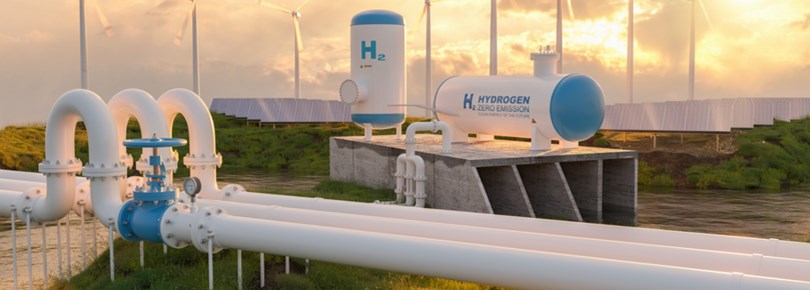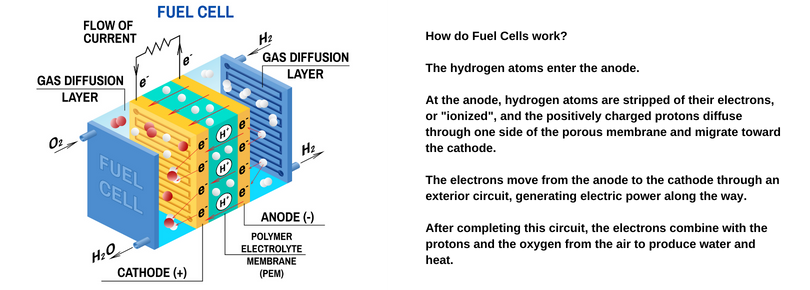Fluorinoid® materials in Green Hydrogen applications
March 2023

Since it makes up around 75% of the universe's chemical composition, Hydrogen is the element that is found in the largest abundance. It is regarded as one of the most effective renewable energy sources at the moment because of how severely pollution and climate change caused by fossil fuel overuse have affected both the Earth and life as we know it.
Due to this, there is a clear increase in demand for a Hydrogen-based renewable energy source.
Hydrogen is produced by water electrolysis, a technology that converts water and renewable energy into Hydrogen and Oxygen making it a clean fuel and a large renewable energy resource.
Hydrogen Applications:
Proton exchange membrane Fuel cells or PEM cells
A fuel cell is a device that generates electricity through an electrochemical reaction, not combustion. In a fuel cell, Hydrogen and Oxygen are combined to generate electricity, heat, and water.
These PEM cells will provide a huge contribution in supplying the world with sustainable energy in the future and fluoropolymers will be playing a significant role in supporting this change by either simply enabling the performance of these units or by increasing the efficiency and lowering the power losses during operational periods.
Fluoropolymers are used as membranes inside fuel cells. The electrolyte layer in the center of each cell is typically made up of a thin film of sulphonated PTFE that only permits protons to pass through.

PTFE and other fluoropolymers are used extensively inside and outside of fuel cells and electrolysers as tubes, hoses, and plugs.
Hydrogen vehicles:
Compared to battery-powered vehicles, Hydrogen-fueled vehicles are more of a niche market.
There are numerous high-performance materials used as seals in valves and compression devices for Hydrogen vehicles. Most sealing materials are made of elastomeric compounds, which have a limited operating temperature range.
In comparison, PTFE, a semicrystalline thermoplastic that is also employed in sealing applications, has the benefit of being usable throughout a much wider temperature range.
And High-density polyethylene (HDPE), a material chosen for its superior performance in combining low Hydrogen permeability and low cost, has traditionally been used as the polymer liner material.
Alternative polymer systems, such as Nylons, which show less Hydrogen permeability, are also being considered.

The main challenge in using Hydrogen its storage, handling, and delivery.
Hydrogen Fuel Cell systems and the related infrastructure for hydrogen distribution and dispensing often require high-performance plastics to achieve a safe and economical construction.

Temperatures in Hydrogen infrastructure and car fuel system applications range from 40°C to about 200°C, the highest being attained by the compressors.
When recommending a material for a Hydrogen application or designing a part, the operating temperature and pressure ranges must be considered.
- PTFE is used for seals in mechanical compressors, O-rings, gaskets, fittings, and valve seats.
- PFA and FEP are also used in the production and storage of Hydrogen power.
- PCTFE and PEEK can be used for seals, gaskets, valve seats and pistons.
- Nylon can be used to make O-rings, fittings, seals, gaskets, and valve seats.
- HDPE is used as liners for Hydrogen storage tanks and pipelines.
- PPS (Polyphenylene sulfide) is used as pipeline liner in high pressure Hydrogen distribution systems.
As part of the Hydrogen infrastructure, these polymers may be subjected to a wide range of pressures (10-100 MPa), temperatures (-70°C to +85°C), and frequently, as in fuel dispensing operations, Hydrogen pressure cycles in addition to temperature cycles.
Depending on the application and temperature range we recommend the use of Fluorinoid® FL102, FL355, FL512, or FL612.
Given its extreme flammability and reactivity, Hydrogen puts a lot of strain on the sealing materials used to contain it.
It is crucial to choose the right material for your application because a proper seal will help minimise gas escape and lower the risk of prolonged exposure.
Contact us today if you would like to discuss your project in more detail!










